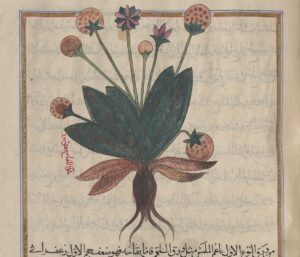This public lecture is part of the workshop Where did they get this? Distinguishing written and non-written sources of knowledge.
Since antiquity, the mandragore has been known as a medicinal plant with analgesic, sedative, and aphrodisiac effects. Mandragore attested in ancient and medieval medical and encyclopaedic texts has been identified with type species Mandragora officinarum, of the genus Mandragora, Solanaceae family. This perennial herbaceous plant contains tropane alkaloids, and depending on the amount ingested, it can lead to convulsions, delirium, hallucination, hyperactivity, and even death.

Mandragore In Arabic Materia Medica, New York Public Library Digital Collections, Spencer Coll. Persian Ms. 39, Fol. 203r. https://digitalcollections.nypl.org/items/5e66b3e8-c0ff-d471-e040-e00a180654d7
Whereas the surviving mediaeval European testimonies on the mandragore seem rather limited to “bookish” knowledge, the Middle Eastern sources on the plant attest to more diverse modalities of transmission. What we see in the Arabic and Persian sources is not only the scholarly transmission of pharmaceutical information on the mandragora of the Dioscoridan tradition. We will look at texts and images describing the method of harvesting the mandragore using a dog, which shed light on the material and economic aspect of the mandragore as a coveted (thus costly and often counterfeited) merchandise, sold in the streets not only for its medicinal qualities but also for its supposed talismanic effects. These sources also give us glimpses into the social and performative context of this more “folkloric” tale of the mandragore-harvesting dog.
I will focus especially on the vagabond charlatans called the “Banū Sāsān” and their practice of fabricating and selling fake mandragore, and try to demonstrate how the migration of this peripatetic people may have contributed to the spreading of tales related to the talismanic quality of the mandragore throughout the Eurasian continent, from Europe to China.
It is a good (and hopefully entertaining) case study on how one can reconstruct “street” knowledge and practice which often had a lower standing in comparison to scholarly writing, but had a surprisingly wide circulation nevertheless.
About the speaker
Yuriko Yamanaka is Professor at the National Museum of Ethnology and the Graduate University of Advanced Studies. She received her PhD from the University of Tokyo in Comparative Literature and Culture. For her book Allegoresis of Alexander: from Antiquity to Mediaeval Islam (Nagoya University Press, 2009, in Japanese) she has been awarded the Japan Academy Medal (2011). She has also edited The Arabian Nights and Orientalism: Perspectives from East and West (I.B. Tauris, 2006), and Cultural History of Marvels in Europe and the Middle East (Nagoya University Press, 2015, in Japanese). She was the principal investigator of a JSPS Grant-in-Aid project “The Natural and the Supernatural in Comparative Perspective”, the result of which was a Special Exhibition “REGNUM IMAGINARIUM: Realm of the Marvelous and Uncanny” held at the National Museum of Ethnology in 2019 (A bilingual catalogue edited by her is available from Kawadeshobo-shinsha).

